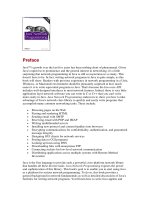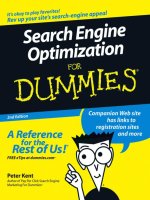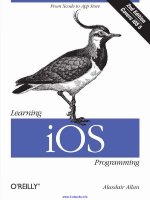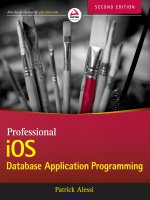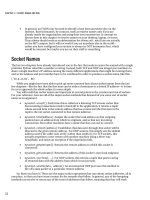Core python programming 2nd edition sep 2006
Bạn đang xem bản rút gọn của tài liệu. Xem và tải ngay bản đầy đủ của tài liệu tại đây (15.81 MB, 1,137 trang )
Praise for Core Python Programming
“The long-awaited second edition of Wesley Chun’s Core Python Programming proves to be well worth the wait—its deep and broad coverage and useful exercises will help readers learn and practice good Python.”
—Alex Martelli, author of Python in a Nutshell and editor of Python Cookbook
“There has been lot of good buzz around Wesley Chun’s Core Python
Programming. It turns out that all the buzz is well earned. I think this is the
best book currently available for learning Python. I would recommend
Chun’s book over Learning Python (O’Reilly), Programming Python
(O’Reilly), or The Quick Python Book (Manning).”
—David Mertz, Ph.D., IBM DeveloperWorks®
“I have been doing a lot of research [on] Python for the past year and have
seen a number of positive reviews of your book. The sentiment expressed
confirms the opinion that Core Python Programming is now considered
the standard introductory text.”
—Richard Ozaki, Lockheed Martin
“Finally, a book good enough to be both a textbook and a reference on the
Python language now exists.”
—Michael Baxter, Linux Journal
“Very well written. It is the clearest, friendliest book I have come across yet
for explaining Python, and putting it in a wider context. It does not presume
a large amount of other experience. It does go into some important Python
topics carefully and in depth. Unlike too many beginner books, it never
condescends or tortures the reader with childish hide-and-seek prose games.
[It] sticks to gaining a solid grasp of Python syntax and structure.”
— bookstore Web site
“[If ] I could only own one Python book, it would be Core Python Programming
by Wesley Chun. This book manages to cover more topics in more depth than
Learning Python but includes it all in one book that also more than
adequately covers the core language. [If] you are in the market for just one
book about Python, I recommend this book. You will enjoy reading it,
including its wry programmer’s wit. More importantly, you will learn Python.
Even more importantly, you will find it invaluable in helping you in your
day-to-day Python programming life. Well done, Mr. Chun!”
—Ron Stephens, Python Learning Foundation
“I think the best language for beginners is Python, without a doubt. My favorite book is Core Python Programming.”
—s003apr, MP3Car.com Forums
“Personally, I really like Python. It’s simple to learn, completely intuitive,
amazingly flexible, and pretty darned fast. Python has only just started to
claim mindshare in the Windows world, but look for it to start gaining lots
of support as people discover it. To learn Python, I’d start with Core Python
Programming by Wesley Chun.”
—Bill Boswell, MCSE, Microsoft Certified Professional Magazine Online
“If you learn well from books, I suggest Core Python Programming. It is by
far the best I’ve found. I’m a Python newbie as well and in three months
time I’ve been able to implement Python in projects at work (automating
MSOffice, SQL DB stuff, etc.).”
—ptonman, Dev Shed Forums
“Python is simply a beautiful language. It’s easy to learn, it’s cross-platform,
and it works. It has achieved many of the technical goals that Java strives for.
A one-sentence description of Python would be: ‘All other languages appear
to have evolved over time—but Python was designed.’ And it was designed
well. Unfortunately, there aren’t a large number of books for Python. The
best one I’ve run across so far is Core Python Programming.”
—Chris Timmons, C. R. Timmons Consulting
“If you like the Prentice Hall Core series, another good full-blown
treatment to consider would be Core Python Programming. It addresses
in elaborate concrete detail many practical topics that get little, if any,
coverage in other books.”
—Mitchell L Model, MLM Consulting
core
programming
Second Edition
PRENTICE HALL
CORE SERIES
Core J2EE Patterns, Second Edition, Alur/Malks/Crupi
Core PHP Programming,Third Edition, Atkinson/Suraski
Core Lego Mindstorms, Bagnall
Core Python Programming, Second Edition, Chun
Core Internet Application Development with ASP.NET 2.0, Connolly
Core JSTL, Geary
Core JavaServer Faces, Second Edition, Geary/Horstmann
Core Web Programming, Second Edition, Hall/Brown
Core Servlets and JavaServer Pages,Volume 1: Core Technologies,
Second Edition, Hall/Brown
Core Servlets and JavaServer Pages,Volume 2:Advanced Technologies,
Second Edition, Hall/Brown
Core Java™ 2,Volume I—Fundamentals, Eighth Edition,
Horstmann/Cornell
Core Java™ 2,Volume II—Advanced Features, Eighth Edition,
Horstmann/Cornell
Core C# and .NET, Perry
Core CSS, Second Edition, Schengili-Roberts
Core Security Patterns, Steel/Nagappan/Lai
Core Java Data Objects,Tyagi/Vorburger/McCammon/Bobzin
Core Web Application Development with PHP and MySQL,
Wandschneider
core
programming
Second Edition
WESLEY J. CHUN
Upper Saddle River, NJ • Boston • Indianapolis • San Francisco • New York
Toronto • Montreal • London • Munich • Paris • Madrid • Capetown
Sydney • Tokyo • Singapore • Mexico City
Many of the designations used by manufacturers and sellers to distinguish their products are claimed as
trademarks. Where those designations appear in this book, and the publisher was aware of a trademark
claim, the designations have been printed with initial capital letters or in all capitals.
The author and publisher have taken care in the preparation of this book, but make no expressed or
implied warranty of any kind and assume no responsibility for errors or omissions. No liability is assumed
for incidental or consequential damages in connection with or arising out of the use of the information or
programs contained herein.
The publisher offers excellent discounts on this book when ordered in quantity for bulk purchases or special sales, which may include electronic versions and/or custom covers and content particular to your business, training goals, marketing focus, and branding interests. For more information, please contact:
U.S. Corporate and Government Sales
(800) 382-3419
For sales outside the United States, please contact:
International Sales
This Book Is Safari Enabled
The Safari® Enabled icon on the cover of your favorite technology book means the
book is available through Safari Bookshelf. When you buy this book, you get free access
to the online edition for 45 days.
Safari Bookshelf is an electronic reference library that lets you easily search thousands of technical books, find
code samples, download chapters, and access technical information whenever and wherever you need it.
To gain 45-day Safari Enabled access to this book:
• Go to informit.com/onlineedition
• Complete the brief registration form
• Enter the coupon code F5JI-KJ2L-9DLR-BWK1-7QBM
If you have difficulty registering on Safari Bookshelf or accessing the online edition, please e-mail
Visit us on the Web: informit.com/ph
Library of Congress Cataloging-in-Publication Data
Chun, Wesley.
Core Python programming / Wesley J. Chun. – 2nd ed.
p. cm.
Includes bibliographical references and index.
ISBN 0-13-226993-7 (pbk. : alk. paper)
1. Python (Computer program language) I. Title.
QA76.73.P98C48 2006
005.13’3–dc22
2006019559
Copyright © 2007 Pearson Education, Inc.
All rights reserved. Printed in the United States of America. This publication is protected by copyright,
and permission must be obtained from the publisher prior to any prohibited reproduction, storage in a
retrieval system, or transmission in any form or by any means, electronic, mechanical, photocopying,
recording, or likewise. For information regarding permissions, write to:
Pearson Education, Inc.
Rights and Contracts Department
501 Boylston Street, Suite 900
Boston, MA 02116
Fax: (617) 671-3447
ISBN 0-13-226993-7
Reprinted with corrections, April 2009
Text printed in the United States on recycled paper at Courier in Stoughton, Massachusetts.
Fifth printing, April 2009
To my parents,
who taught me that everybody is different.
And to my wife,
who lives with someone who is different.
This page intentionally left blank
Preface
xxiii
Acknowledgments
xxxv
P A RT I :
1
CORE PYTHON
2
WELCOME TO PYTHON!
4
1.1 What Is Python?
5
1.2 Origins
6
1.3 Features
6
1.4 Downloading and Installing Python
11
1.5 Running Python
13
1.6 Python Documentation
22
1.7 Comparing Python
23
ix
x
Contents
2
1.8 Other Implementations
26
1.9 Exercises
27
GETTING STARTED
30
2.1 Program Output, the print Statement, and “Hello World!”
32
2.2 Program Input and the raw_input() Built-in Function
33
2.3 Comments
35
2.4 Operators
35
2.5 Variables and Assignment
37
2.6 Numbers
37
2.7 Strings
39
2.8 Lists and Tuples
40
2.9 Dictionaries
40
2.10 Code Blocks Use Indentation
41
2.11 if Statement
41
2.12 while Loop
42
2.13 for Loop and the range() Built-in Function
43
2.14 List Comprehensions
45
2.15 Files and the open() and file() Built-in Functions
46
2.16 Errors and Exceptions
47
2.17 Functions
48
2.18 Classes
50
2.19 Modules
52
Contents
3
4
5
2.20 Useful Functions
54
2.21 Exercises
55
PYTHON BASICS
60
3.1 Statements and Syntax
61
3.2 Variable Assignment
64
3.3 Identifiers
67
3.4 Basic Style Guidelines
69
3.5 Memory Management
75
3.6 First Python Programs
79
3.7 Related Modules/Developer Tools
84
3.8 Exercises
85
PYTHON OBJECTS
88
4.1 Python Objects
89
4.2 Standard Types
91
4.3 Other Built-in Types
91
4.4 Internal Types
93
4.5 Standard Type Operators
96
4.6 Standard Type Built-in Functions
101
4.7 Type Factory Functions
111
4.8 Categorizing the Standard Types
111
4.9 Unsupported Types
116
4.10 Exercises
117
NUMBERS
120
5.1 Introduction to Numbers
121
5.2 Integers
122
xi
xii
Contents
6
5.3 Double Precision Floating Point Numbers
125
5.4 Complex Numbers
126
5.5 Operators
127
5.6 Built-in and Factory Functions
136
5.7 Other Numeric Types
145
5.8 Related Modules
148
5.9 Exercises
151
SEQUENCES: STRINGS, LISTS, AND TUPLES
156
6.1 Sequences
158
6.2 Strings
168
6.3 Strings and Operators
170
6.4 String-Only Operators
178
6.5 Built-in Functions
184
6.6 String Built-in Methods
188
6.7 Special Features of Strings
192
6.8 Unicode
197
6.9 Related Modules
206
6.10 Summary of String Highlights
208
6.11 Lists
209
6.12 Operators
211
6.13 Built-in Functions
216
6.14 List Type Built-in Methods
220
6.15 Special Features of Lists
224
6.16 Tuples
232
Contents
7
8
6.17 Tuple Operators and Built-in Functions
233
6.18 Special Features of Tuples
235
6.19 Related Modules
239
6.20 *Copying Python Objects and Shallow and Deep Copies
240
6.21 Summary of Sequences
243
6.22 Exercises
246
MAPPING AND SET TYPES
252
7.1 Mapping Type: Dictionaries
253
7.2 Mapping Type Operators
258
7.3 Mapping Type Built-in and Factory Functions
260
7.4 Mapping Type Built-in Methods
265
7.5 Dictionary Keys
268
7.6 Set Types
273
7.7 Set Type Operators
276
7.8 Built-in Functions
280
7.9 Set Type Built-in Methods
281
7.10 Operator, Function/Method Summary Table for Set Types
283
7.11 Related Modules
283
7.12 Exercises
285
CONDITIONALS AND LOOPS
290
8.1 if Statement
291
8.2 else Statement
292
xiii
xiv
Contents
9
8.3 elif (aka else-if) Statement
294
8.4 Conditional Expressions (aka “the Ternary Operator”)
295
8.5 while Statement
296
8.6 for Statement
298
8.7 break Statement
304
8.8 continue Statement
305
8.9 pass Statement
306
8.10 else Statement . . . Take Two
307
8.11 Iterators and the iter() Function
309
8.12 List Comprehensions
313
8.13 Generator Expressions
315
8.14 Related Modules
320
8.15 Exercises
320
FILES AND INPUT/OUTPUT
324
9.1 File Objects
325
9.2 File Built-in Functions [open() and file()]
326
9.3 File Built-in Methods
329
9.4 File Built-in Attributes
336
9.5 Standard Files
337
9.6 Command-Line Arguments
338
9.7 File System
339
9.8 File Execution
348
9.9 Persistent Storage Modules
348
Contents
10
11
9.10 Related Modules
351
9.11 Exercises
353
ERRORS AND EXCEPTIONS
358
10.1 What Are Exceptions?
360
10.2 Exceptions in Python
361
10.3 Detecting and Handling Exceptions
364
10.4 Context Management
382
10.5 *Exceptions as Strings
386
10.6 Raising Exceptions
386
10.7 Assertions
389
10.8 Standard Exceptions
391
10.9 *Creating Exceptions
394
10.10 Why Exceptions (Now)?
401
10.11 Why Exceptions at All?
402
10.12 Exceptions and the sys Module
403
10.13 Related Modules
404
10.14 Exercises
405
FUNCTIONS AND FUNCTIONAL PROGRAMMING
408
11.1 What Are Functions?
409
11.2 Calling Functions
412
11.3 Creating Functions
418
11.4 Passing Functions
426
xv
xvi
Contents
12
13
11.5 Formal Arguments
428
11.6 Variable-Length Arguments
433
11.7 Functional Programming
439
11.8 Variable Scope
453
11.9 *Recursion
466
11.10 Generators
467
11.11 Exercises
471
MODULES
476
12.1 What Are Modules?
477
12.2 Modules and Files
478
12.3 Namespaces
480
12.4 Importing Modules
484
12.5 Features of Module Import
486
12.6 Module Built-in Functions
491
12.7 Packages
493
12.8 Other Features of Modules
496
12.9 Related Modules
500
12.10 Exercises
501
OBJECT-ORIENTED PROGRAMMING
504
13.1 Introduction
506
13.2 Object-Oriented Programming
514
13.3 Classes
518
13.4 Class Attributes
520
Contents
14
13.5 Instances
526
13.6 Instance Attributes
531
13.7 Binding and Method Invocation
540
13.8 Static Methods and Class Methods
542
13.9 Composition
544
13.10 Subclassing and Derivation
545
13.11 Inheritance
547
13.12 Built-in Functions for Classes, Instances, and Other Objects
558
13.13 Customizing Classes with Special Methods
564
13.14 Privacy
585
13.15 *Delegation
587
13.16 Advanced Features of New-Style Classes (Python 2.2+)
595
13.17 Related Modules and Documentation
615
13.18 Exercises
618
EXECUTION ENVIRONMENT
626
14.1 Callable Objects
628
14.2 Code Objects
635
14.3 Executable Object Statements and Built-in Functions
636
14.4 Executing Other (Python) Programs
649
14.5 Executing Other (Non-Python) Programs
653
14.6 Restricted Execution
663
14.7 Terminating Execution
663
14.8 Miscellaneous Operating System Interface
666
xvii
xviii
Contents
14.9 Related Modules
668
14.10 Exercises
668
PART II:
15
16
17
ADVANCED TOPICS
REGULAR EXPRESSIONS
670
672
15.1 Introduction/Motivation
673
15.2 Special Symbols and Characters
676
15.3 REs and Python
683
15.4 Regular Expressions Example
698
15.5 Exercises
705
NETWORK PROGRAMMING
710
16.1 Introduction
711
16.2 Sockets: Communication Endpoints
715
16.3 Network Programming in Python
718
16.4 *SocketServer Module
732
16.5 *Introduction to the Twisted Framework
737
16.6 Related Modules
741
16.7 Exercises
742
INTERNET CLIENT PROGRAMMING
746
17.1 What Are Internet Clients?
747
17.2 Transferring Files
748
17.3 Network News
756
Contents
18
19
20
17.4 Electronic Mail
766
17.5 Related Modules
778
17.6 Exercises
779
MULTITHREADED PROGRAMMING
786
18.1 Introduction/Motivation
787
18.2 Threads and Processes
789
18.3 Python, Threads, and the Global Interpreter Lock
790
18.4 thread Module
795
18.5 threading Module
800
18.6 Related Modules
814
18.7 Exercises
814
GUI PROGRAMMING
818
19.1 Introduction
819
19.2 Tkinter and Python Programming
821
19.3 Tkinter Examples
826
19.4 Brief Tour of Other GUIs
840
19.5 Related Modules and Other GUIs
848
19.6 Exercises
851
WEB PROGRAMMING
854
20.1 Introduction
855
20.2 Web Surfing with Python: Creating Simple Web Clients
859
xix
xx
Contents
21
22
23
20.3 Advanced Web Clients
869
20.4 CGI: Helping Web Servers Process Client Data
875
20.5 Building CGI Applications
878
20.6 Using Unicode with CGI
892
20.7 Advanced CGI
894
20.8 Web (HTTP) Servers
906
20.9 Related Modules
909
20.10 Exercises
913
DATABASE PROGRAMMING
918
21.1 Introduction
919
21.2 Python Database Application Programmer’s Interface (DB-API)
924
21.3 Object-Relational Managers (ORMs)
946
21.4 Related Modules
958
21.5 Exercises
960
EXTENDING PYTHON
962
22.1 Introduction/Motivation
963
22.2 Extending Python by Writing Extensions
965
22.3 Related Topics
981
22.4 Exercises
982
MISCELLANEOUS
984
23.1 Web Services
985
23.2 Programming Microsoft Office with Win32 COM
989
Contents
23.3 Python and Java Programming with Jython
1002
23.4 Exercises
1006
Appendix A
Answers to Selected Exercises
Appendix B Reference Tables
1011
1021
Appendix C Python 3: The Evolution Of A Programming
Language
1049
Appendix D Migrating to Python 3 Starts with 2.6
1059
Index
1071
xxi
This page intentionally left blank
Welcome to Core Python
Programming!
We are delighted that you have engaged us to help you learn Python as
quickly and as in-depth as possible. Learning the syntax is one goal of this
book; however, we also believe that if you learn how Python works under the
covers, you won’t just be able to program in Python, but you will write more
effective Python applications even as a beginner to the language. As you know,
just because you learn a language’s syntax does not make you competent in it
right away.
Throughout the book, you will find many examples that you can try right in
front of your computer. To hammer the concepts home, you will also find fun
and challenging exercises at the end of every chapter. These easy and intermediate exercises are meant to test your learning and push your Python skills.
There simply is no substitute for experience. We believe you should not only
pick up Python programming skills but also be able to master them in as short
a time period as possible.
xxiii
xxiv
Preface
About This Book
This book differs from other Python books on the market by presenting a
broad range of topics, providing numerous examples, and going in-depth
where necessary. This book does not require a specific background such as
prior knowledge of C or object-oriented programming. It is also not a large
case study book that does not facilitate picking up the language quickly.
Finally, this book is not a pure reference nor is it meant to be a quick “dive”
into Python. What we have is an extremely comprehensive introduction to
the core features of the language (Part I) followed by a set of chapters that
delve into specific areas of intermediate Python programming.
This book is 40 percent introductory, 40 percent intermediate to advanced,
and 20 percent reference. It is targeted toward technical professionals who are
already familiar with programming in one other high-level language, as well as
university/college and secondary students. Because Python is used in larger
solutions such as Zope, Plone, MailMan, and Django, this book may be used by
principals developing, managing, maintaining, or integrating with those systems.
With regards to the code in this book, about a third of the first edition
readers sent in complaints that there were not enough large, full-fledged applications in the book, or that the code examples were not long or comprehensive
enough. Everyone else wrote that they loved the short, easy-to-understand
examples and were not bored of page after page of mind-numbing code. The
philosophy behind more short examples is to give you the ability to look at a
piece of code and grasp its entirety. These turn into building blocks to understanding and then can be incorporated into larger applications as well. There
are line-by-line explanations for most of the larger programs in the book.
The abundant interpreter code snippets scattered throughout the book are
there for you to try on your computer as you are learning Python—use the
interactive interpreter as much as possible. You not only learn and improve
your Python from using it, but you can also benefit from working out bugs in
your code before you paste it into your source file.
Because you cannot learn Python well without practice, you will find the
exercises at the end of every chapter to be one of the greatest strengths of
this book. They will test your knowledge of chapter topics and definitions, as
well as get you to code as much as possible. There is no substitute to learning
a programming language faster and more effectively than by building applications. You will find easy, intermediate, and difficult problems to solve. It is
also here that you may have to write one of those “large” applications that
many readers wanted to see in the book, but rather than having me do it, you
gain the most from such exercises. Appendix A features answers to selected
problems from each chapter.

